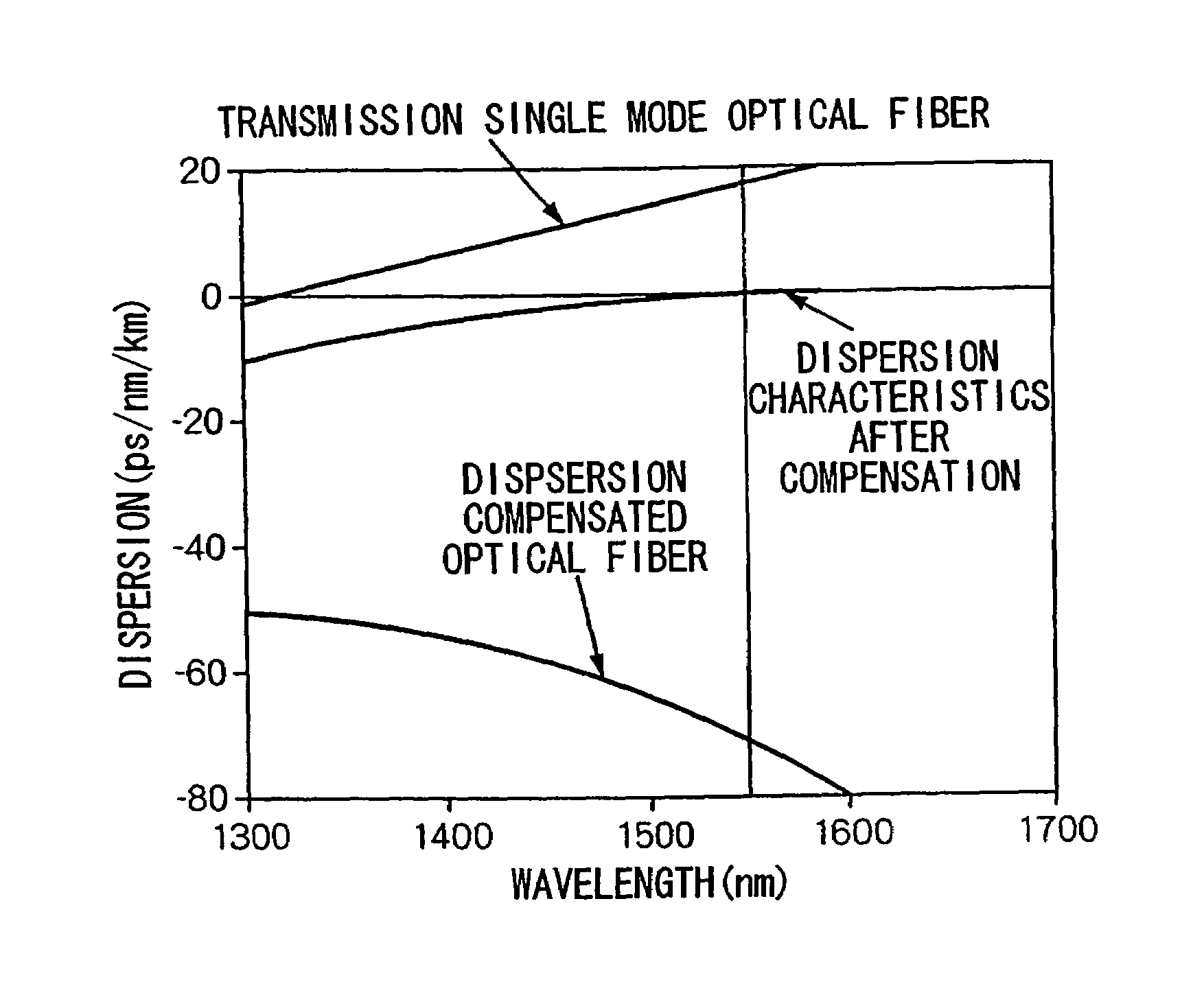Dispersion compensating optical fiber
a technology of optical fiber and compensating fiber, applied in the direction of glass optical fiber, cladded optical fiber, instruments, etc., can solve the problems of accumulated wavelength dispersion, loss increase, transmission characteristics deterioration,
- Summary
- Abstract
- Description
- Claims
- Application Information
AI Technical Summary
Benefits of technology
Problems solved by technology
Method used
Image
Examples
example 1
[0080]Dispersion-compensated optical fibers are produced with a W-type profile shown in FIG. 1(b) and a W-type profile with a ring shown in FIG. 1(c) according to a commonly known method such as a VAD method, an MCVD method, or a PCVD method. Under such a condition, values such as Δ1, Δ2, Δ3, b / a, c / b, a core radius, a diameter of the cladding, an outer diameter of a first coating layer, and an outer diameter of a second coating layer are made so as to be values shown in a TABLE 1 under condition that an atmospheric oxygen density should be 0.1% or lower (0.0% when it is displayed) when an ultraviolet-ray-curable resin is hardened while being drawn.
[0081]Here, a dispersion-compensated optical fiber in No. 1 is produced so as to have an outer diameter of the conventional cladding and a coating structure for a purpose of a comparison. The dispersion-compensated optical fibers shown in No. 2 to No. 6 are examples of the optical fiber according to the present invention.
[0082]
TABLE 1FIRS...
example 2
[0089]Four variations of dispersion-compensated optical fibers with a W-type profile shown in FIG. 1(c) are produced according to a commonly known method such as a VAD method, an MCVD method, or a PCVD method. Under such a condition, values such as Δ1, Δ2, Δ3, b / a, c / b, and a core radius are made so as to be values shown in a TABLE 4 under condition that an atmospheric oxygen density should be 0.1% or lower (0.0% when it is displayed) when an ultraviolet-ray-curable resin is hardened while being drawn.
[0090]Here, a dispersion-compensated optical fibers in No. 7 to No. 9 are produced so as to have conventional dispersion characteristics for a purpose of a comparison. The dispersion-compensated optical fiber shown in No. 2 is an example of the optical fiber according to the present invention.
[0091]
TABLE 4FIRSTSECONDCLADDINGCOATINGCOATINGCOREOUTEROUTEROUTERSURFACERADIUSDIAMETERDIAMETERCIAMETERVISCOSITYNo.Δ1(%)Δ2(%)Δ3(%)b / ac / b(μm)(μm)(μm)(μm)(gf / mm)22.00−0.460.362.71.56.4901351750.171.6...
example 3
[0098]Five variations of dispersion-compensated optical fibers with a W-type profile shown in FIG. 1(b) or with a W-type profile with ring as shown in FIG. 1(c) are produced according to a commonly known method such as a VAD method, an MCVD method, or a PCVD method Under such a condition, values such as Δ1, Δ2, Δ3, b / a, c / b, a core radius, a diameter of the cladding, an outer diameter of a first coating layer, and an outer diameter of a second coating layer are made so as to be values shown in a TABLE 1 under condition that an atmospheric oxygen density should be 0.1% or lower (0.0% when it is displayed) when an ultraviolet-ray-curable resin is hardened while being drawn.
[0099]Here, a dispersion-compensated optical fibers in No. 12 to No. 13 are produced so as to have conventional dispersion characteristics for a purpose of a comparison. The dispersion-compensated optical fiber shown in No. 2, No. 10, and No. 11 are examples of the optical fiber according to the present invention.
[0...
PUM
 Login to View More
Login to View More Abstract
Description
Claims
Application Information
 Login to View More
Login to View More - R&D
- Intellectual Property
- Life Sciences
- Materials
- Tech Scout
- Unparalleled Data Quality
- Higher Quality Content
- 60% Fewer Hallucinations
Browse by: Latest US Patents, China's latest patents, Technical Efficacy Thesaurus, Application Domain, Technology Topic, Popular Technical Reports.
© 2025 PatSnap. All rights reserved.Legal|Privacy policy|Modern Slavery Act Transparency Statement|Sitemap|About US| Contact US: help@patsnap.com



